Where: The patio at Clouds Brewing, 126 N. West Street in Raleigh
Date: Thursday, April 11, 2024
Time: 5:30 PM socializing begins, 7:00 buffet dinner, 8:00 Kim’s talk
Fee:
AEG and ASCE members $35 ($40 if paid at the door)
non-members $50 ($55 if paid at the door)
public-sector employees and teachers $20 ($25 if paid at the door)
Students free/$1 with college ID. Students must register by April 6 online for $1 or by emailing Rick Kolb.
Reservations: Please make reservations and prepay by 6:00 PM on Monday, April 8, 2024.
Continuing Education: The NCBLG has preapproved AEG Carolinas to offer 1 CE credit for our chapter meetings.
Speaker: Kim Nimmer, Senior Policy Analyst, City of Raleigh
Topic: We had USTs in the 1990s, chlorinated solvents and vapor intrusion in the 2000s, and PFAS in this decade. What’s the next big topic in environmental consulting, the next “contaminant of emerging concern” that we will deal with? Some of you are old enough to remember the movie, The Graduate, during which Dustin Hoffman was pulled aside at his graduation party by one of his dad’s friends, who told him the future in one word --- “Plastics.” Well, here we are, over 50 years later and plastics are everywhere - in the ocean, in the food chain, in our blood stream; yes, everywhere. Is this a big deal?
Abstract: What’s the Big Deal with Small Plastic? Plastics have become pervasive in modern life and are now used in a wide range of commercial and industrial applications. Microplastics may be intentionally produced for specific purposes and products or may result from the degradation and fragmentation of larger plastics. Regardless of their origin, microplastics are now ubiquitous in our environment and are one of the biggest emerging threats to the global environmental community.
Because of their small size and pervasiveness in the environment, microplastics, along with any other contaminants that are adsorbed to the microplastics or intentionally added through the manufacturing process, may be consumed by humans and other organisms. Microplastics have been reported in human blood, in the deep lung, and in placenta. The science surrounding microplastics, their potential health effects, and knowledge of their fate and transport are very new and developing, with research articles being published at a rapidly accelerating rate. Even techniques and best practices for sample collection and analysis of these tiny particles and fibers are still evolving. Kim will highlight information from the Interstate Technology and Regulatory Council’s (ITRC) Microplastics Guidance Document, which was released online in February 2023. The guidance provides the reader with information on microplastics and the state of the applied science without having to go to the scientific literature.
Bio: Kim Nimmer is a Senior Policy Analyst with the City of Raleigh and was co-leader of the ITRC’s Microplastics Team that produced the ITRC Microplastics Guidance Document. She currently co-leads a group on ITRC’s Contaminants of Emerging Concern Team. Kim previously spent 20 years with the North Carolina Department of Environmental Quality’s Division of Water Resources (DWR), where she served as DWR’s first Emerging Compounds Coordinator. She also served as the Interbasin Transfer Program Coordinator and managed the state’s 319(h) grant from the U.S. Environmental Protection Agency to protect and restore waters impaired by nonpoint source pollution. Kim has worked in private consulting, the nonprofit sector, and Wisconsin state government, working on stream-restoration projects, site assessments for Superfund and Brownfields sites, and the development of state technical standards for soil- and water-conservation practices. Kim holds an M.S. in Water Resources Management from the University of Wisconsin at Madison and a B.S. in Geology from the University of North Carolina at Chapel Hill.
